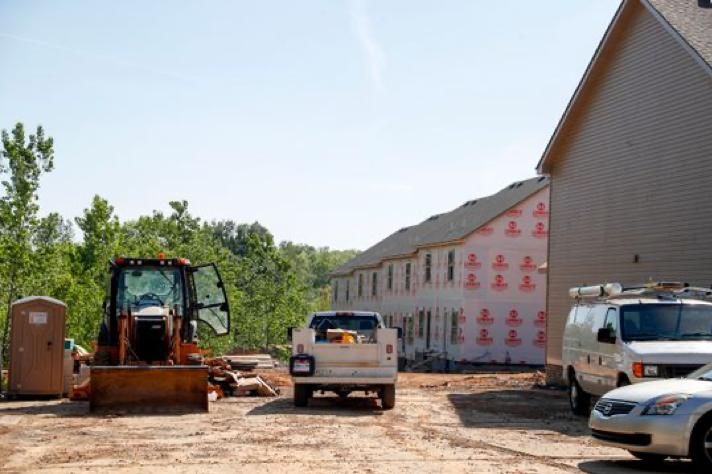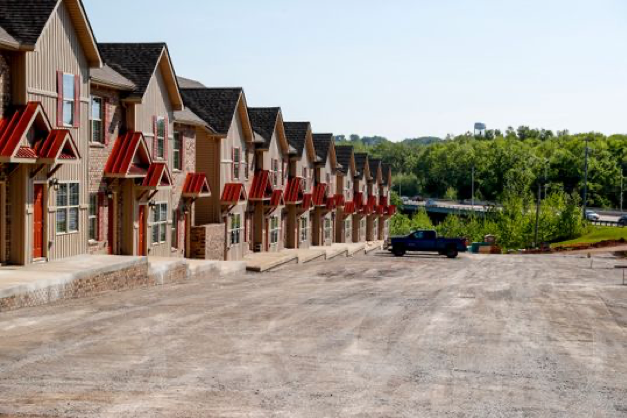Jimmy Settle, Clarksville Leaf-Chronicle Published 6:35 a.m. CT April 30, 2019 | Updated 10:21 a.m. CT April 30, 2019
Story Highlights
• The county’s total population will swell by 40 percent, or an additional 90,455 new residents, over the next 20 years.
• County Mayor Jim Durrett has called for an update of the state-mandated Urban Growth Plan.
• Through growth, between 2002-12, Montgomery County lost almost 20,000 acres of farmland.

Construction work can be seen at the 1500 block of Wilma Rudolph Blvd. in Clarksville, Tenn., on Monday, April 29, 2019. It’s an example of the infill development that planners said is needed to accommodate growth without adding to sprawl.
(Photo: HENRY TAYLOR/The Leaf-Chronicle)
Official projections say Montgomery County’s total population will swell by 40 percent, or an additional 90,455 new residents, over the next 20 years, yielding the community a total head count of 298,919 people by 2040.
The state recognizes these numbers from the University of Tennessee as the projection that planners should prepare for, and while past projections from UT have been below reality — in some cases significantly below the mark by as many as 9,000 people, it’s at least a given that Montgomery County is going to see major net changes along with the rest of a booming Middle Tennessee.
With this in mind, Montgomery County Mayor Jim Durrett has called for a 20-year update of the state-mandated Urban Growth Plan for the community, and the six-month process was launched with a Monday morning organizational meeting of the community’s appointed Growth Coordinating Committee, held at the courthouse.

Construction work can be seen at the 1500 block of Wilma Rudolph Blvd. in Clarksville, Tenn., on Monday, April 29, 2019. It’s an example of the infill development that planners said is needed to accommodate growth without adding to sprawl. (Photo: HENRY TAYLOR/The Leaf-Chronicle)
While there are numerous designated members of the committee, officials also want public input in the process, as the lines are redrawn for these Montgomery County growth boundaries:
Urban Growth Boundary (UGB), which is the existing Clarksville city limits plus any contiguous territory where higher-density residential, commercial and industrial growth is expected over the next 20 years, and which is available for potential city annexation
Planned Growth Areas (PGA), defined as territory outside of the city limits and the UGB, where low- to- moderate-density residential, commercial and industrial growth is projected within the next 20 years, but is not available for annexation
Rural Area (RA), which is the remainder of the county not included in the UGB or PGA, where low-density residential development, farmland preservation, forest and wildlife management, and recreational opportunities are the priority.
As population projections influence where growth happens over the next 20 years, the Growth Coordinating Committee will also be taking a hard look at the strain on, placement of, and expansion of, roads and utilities.
Infill apartments vs. sprawl
One key question within the 20-year planning process is this: Assuming the net, new number of residents from UT proves to be correct, can all the housing needed for them fit within the existing boundaries of the city of Clarksville?
Will infill development meet the population growth demand without creating more urban sprawl into traditionally-rural areas of the county?
Regional Planning Commission Director Jeff Tyndall thinks it’s possible to do it all with infill development, but it would be a challenge, requiring some creative zoning for land uses in some cases.
“One obvious point that we have to establish as we launch this long-range planning process is that, land is finite,” Tyndall said. “Montgomery County cannot make more land to develop.
“It’s also very important for us to understand that, once land is developed, it is extremely difficult, for several decades, to increase density or redevelop properties or subdivisions.”
“So, using land wisely,” Tyndall said, “means using a mix of housing options to include multi-family (apartments or condos) or higher-density detached housing units. More wise choices with every acre of undeveloped property will lead to less land being used up as quickly.”
Losing farmland
The decline of agriculture as acreage is gobbled up for residential and commercial development through urban sprawl is a key concern for many residents — particularly for those from rural areas of Montgomery County.
Farm income and production is still important to the local economy. The UT Extension Service estimates Montgomery County’s total direct agricultural output at $370.4 million, and adding in multiplier effects, farming still has a $505 million economic impact countywide.
But between 2002-12, Montgomery County lost almost 20,000 acres of farmland, and the total number of farms declined from 1,100 to about 780.
To further illustrate the rate of change, between October 2017 and October 2018, 215 acres of Montgomery County’s agriculturally-zoned property were converted to residential, commercial or industrial land uses.
Planning for growth
The Growth Coordinating Committee was previously assigned last year to reclassifying 600 acres along and around Rossview Road — including the 300 acres for the city’s planned family athletic complex — from PGA to UGB designations, which ultimately led to the city’s annexation of those areas.

Regional Planning Commission Director Jeff Tyndall leads the Monday morning launch of an urban growth planning effort for Montgomery County.
(Photo: Jimmy Settle/The Leaf-Chronicle)
Following that, Durrett formally requested the more comprehensive review and rewrite of the countywide Urban Growth Plan — the process which officially began Monday.
Here are the appointed members of the Growth Coordinating Committee, who will have a major influence on Montgomery County’s growth patterns over the next 20 years:
Voting members
• Chairman: County Commissioner Larry Rocconi, Regional Planning Commission
• Vice Chairman: Mark Kelly (for Clarksville Mayor Joe Pitts), Regional Planning Commission
• Richard Swift (chairman, Regional Planning Commission)
• Bryce Powers (vice chairman, Regional Planning Commission)
• Bill Kimbrough (for Montgomery County Mayor Jim Durrett), Regional Planning Commission
• City Councilman Richard Garrett (Regional Planning Commission)
• Dr. Amanda Walker (Regional Planning Commission)
• Wade Hadley (Regional Planning Commission)
• Russell Adkins (Regional Planning Commission)
• Daniel Kimbell (Clarksville Department of Electricity)
• Norm Brumblay (Clarksville-Montgomery County School System)
• Mark Riggins (Clarksville Gas & Water)
• Jonathan Fielder (Cumberland Electric Membership Corporation)
• Mark Cook (Cumberland Electric Membership Corporation)
• Jeff Truitt (Clarksville-Montgomery County Economic Development Council)
• Connie Cooper (Montgomery County resident)
• Phillip Hagewood (Montgomery County resident)
• Ex-officio members
• Chris Brown (Department of Public Works, Fort Campbell)
• David Draper (Department of Plans, Training, Mobilization and Security, Fort Campbell)
• County Commissioner Joe Smith
• City Councilwoman Valerie Guzman
• Frank Tate (Industrial Development Board)
• Rex Hawkins (Clarksville-Montgomery County Homebuilders Association)
• Christian Black (Clarksville Association of Realtors)
• Grayson Smith (DBS & Associates Engineering)
• Vernon Weakley (Weakley Brothers Engineering)
• Cal Burchett (McKay-Burchett & Company Engineers)
Reach Business Editor Jimmy Settle at 931-245-0247 and on Twitter @settle_leaf